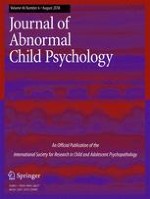16-10-2017
Distilling Heterogeneity among Children with Disruptive Behavior: Associations between Symptom Patterns and Social Functioning
Gepubliceerd in: Research on Child and Adolescent Psychopathology | Uitgave 6/2018
Log in om toegang te krijgenAbstract
Children with disruptive behavior (DB) are a heterogeneous group who exhibit several characteristics that may contribute to poor social functioning. The present study identified profiles of reactive aggression, proactive aggression, callous-unemotional (CU) traits, and prosocial behavior in a sample of children with DB. Associations with social functioning (social interaction, social status) were then examined, along with sex differences in profile membership. Parent ratings of 304 clinic-referred children ages 6–12 years with DB were analyzed using latent profile analysis. Five profiles were identified: 1) Moderate prosocial behavior, reactive aggression, and CU, and low proactive aggression (labelled Moderate); 2) Relatively high prosocial behavior and low reactive and proactive aggression and CU traits (Prosocial); 3) High prosocial behavior and reactive aggression, moderate proactive aggression, and low-moderate CU (Reactive-Prosocial); 4) Low prosocial behavior, high CU, high-moderate reactive aggression, and low-moderate proactive aggression (Reactive-CU); and 5) Low prosocial behavior and high reactive and proactive aggression and CU (Aggressive-CU). Profiles characterized by CU traits, reactive aggression, and low prosocial behavior were associated with the most problematic parent-rated social interaction and social status. The results highlight the need to differentiate profiles of psychopathology in children with DB to better address factors most associated with social functioning.
